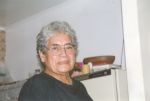Kiorana Porongahau
 Rarotongans Sophie Ngati Ka Ou (pictured right) and Leone Ta Okia recall working and living with Tom and Margeret Hope, on a farm at Porangahau, in Southern Hawkes Bay. They joined hundreds of Cook Islanders who came as part of a scheme aimed to fill the gaps left by men and women who had gone to war, back in the 1940s and 50s.
Rarotongans Sophie Ngati Ka Ou (pictured right) and Leone Ta Okia recall working and living with Tom and Margeret Hope, on a farm at Porangahau, in Southern Hawkes Bay. They joined hundreds of Cook Islanders who came as part of a scheme aimed to fill the gaps left by men and women who had gone to war, back in the 1940s and 50s.
These days coming by plane into the Cook Islands, means a ukelele welcome, the sweet smell of frangipani, and of course balmy tropical temperatures.
Turning the tables, and the clock back to the early 1940s, the experience for Rarotongans who left their Island communities to come to New Zealand for the first time, was very different.
Hundreds of Cook Islanders took up the opportunity provided by a New Zealand Government scheme aimed at filling places left by men and women who'd gone away to war.
Sophie Ngati Ka Ou and Leone Ta Okia, both living back in Rarotonga at the time of this interview, recall the extraordinary adventure of coming to a remote station in Southern Hawkes Bay, where they worked and lived with Margeret and Tom Hope and their three children at Otama, near Porongahau.
The culture shock was extreme, as they learnt the importance of laying tables the correct way, of making bread and butter puddings for the master, and were gently counseled about the ways of the world, by Mrs Hope.
Homesickness and illness were part of the adjustment to the new diet, climate and extraordinary scale of New Zealand, as compared to their home. But a community of Rarotongans, also living in larger numbers at Mrs Hope's family home of Wallingford nearby, meant the experience was one of great happiness, and lead to ongoing working lives and marriages within New Zealand, before ultimately returning for their latter years to their homes in Rarotonga.
Produced by Deborah Nation for Radio New Zealand